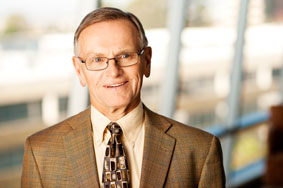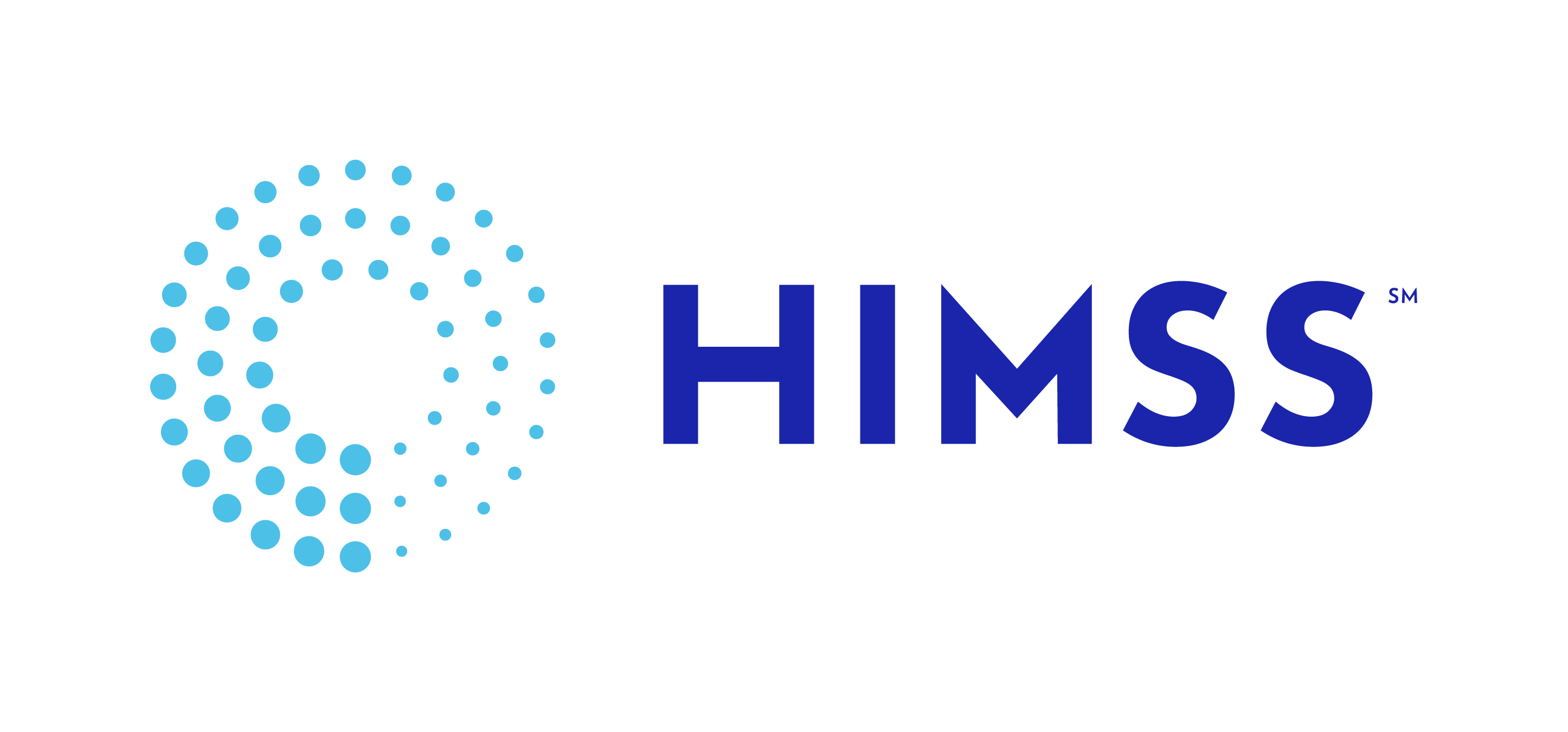Spring 2014CIO Corner
by Dianne Baker
One of our own nationally recognized IT Leaders, Bill Spooner, “retires” from his role as SVP and CIO at Sharp HealthCare
Bill Spooner leaves behind a strong legacy of leadership and innovation within his organization and across our healthcare industry. Bill has been chief information officer for more than 18 of his 30 plus years at Sharp HealthCare. Through that time, he has led an aggressive IT effort that placed Sharp on the Hospitals and Health Networks “100 Most Wired” list for 13 of the list’s 15 years. IT was also cited for its contributions to Sharp’s 2007 Malcolm Baldrige National Quality Award. Sharp was again an early leader in electronic health records and has received several awards for its consumer website.
Bill has also been recognized for his contributions as a national leader and received the prestigious “CIO of the Year” award from both HIMSS and Chime. He shared with us that to have success as an IT Leader today – it is critical to effectively communicate the organization’s strategy across the entire workforce. And their success is “all about the people” - Bill noted his tremendous experience of working with a very cohesive and dedicated team of 450 FTEs and 65 clinicians in the Sharp HealthCare IT group, in addition to the entire Sharp community.
Bill, our Southern California HIMSS community extends its thanks for your tremendous contribution and wishes you and your family a long and enjoyable “retirement”.
******************
Bernie Monegain, Editor of Healthcare IT News, shares their recent interview with Bill Spooner as he reflects on 18 years as CIO of Sharp HealthCare in San Diego:
Bill Spooner's health IT journey goes on
April 8, 2014
/1-JSPS/1%20-%20SoCal%20HIMSS/Old%20Website/Newsletters/Spring%202014/Spring%202014_files/Bill_Spooner_1.jpg)
 Over his 18 years as CIO at Sharp HealthCare in San Diego, Spooner has witnessed vast technology progress.
Over his 18 years as CIO at Sharp HealthCare in San Diego, Spooner has witnessed vast technology progress.Bill Spooner “retired” from his post as leader of Sharp HealthCare’s 450-member IT team on Feb. 14. The quotes around “retired” are necessary because he has something in the works – he won’t say what yet. It’s something that will keep him working halftime, or maybe more. It's too hard to leave healthcare IT altogether at this promising juncture, he says.
It’s an exciting time in health IT, and he’s not ready to give it up. But, he is also looking forward to spending time driving his 1957 John Deere tractor around the 22 acres of land where he and his wife bought a home in eastern Tennessee nearly nine years ago, with an eye toward retirement. It seems fitting. Spooner grew up on a dairy farm in upstate New York. The vintage tractor is the same one his dad bought new back on the farm. First order of business when Spooner gets to Tennessee is cleaning the carburetor and getting it started. “I was not about to let the tractor go away,” he said.
All told, Spooner has worked at Sharp for 35 years, starting in 1978 as a financial analyst and consultant. Three years later he was named CFO of Sharp’s second hospital. He moved to the IT side sometime in the mid ’80s, and on March 1, 1996, he became the CIO.
Before he left for Tennessee, we talked with Spooner about his work, the increasing demands of the job, his take on meaningful use and the changing role of the healthcare CIO.
Q: You made the transition from CFO to CIO. Is that a common thing?
A: "I’m not sure if it’s common or not. But I have friends and colleagues who come from many different backgrounds, some who are actually CPAs. They may have come in from an accounting firm, or consulting firm. There are great nurses who have taken the role of pharmacists. It was good for me moving into IT at the time that I did because the financial systems were the dominant computer applications at the time. We were just starting to stick our toe in the water around clinical systems in the mid ’80s. At the time I moved over I was familiar with billing, accounting, payroll, inventory, all of that stuff, and I had to learn the clinical side over the years. But it was a natural transition for me then."
Q: How are things different today than when you started as CIO 18 years ago?
A: "At that time, we had the basic order entry systems. We were just getting into using online systems, but they weren’t systems that for the most part were being used by clinicians. A lot of the work was being done by clerical staff. Documentation for the most part was still manual. Eighteen years ago, if the systems went down, you still knew how to do things manually, and they weren’t so complex that you couldn’t for a short period of time. The biggest change in the patient care processes revolve around the technology, and it’s really indispensable. For the past several years the focus has been on reducing the scheduled downtime. There’s no time that it’s convenient to turn those computers off. The technology is not at the point where we can upgrade in flight."
Q: What’s tested you the most?
A: "What has probably tested me the most is being a non-clinical person when your whole mission is providing technology support for clinical practice. I almost never go through without recognizing how much I have to learn. It’s just so important to be able to partner with the clinical side of the business to be able to really do the best work for them. That’s the most challenging."
Another challenge
"Like many of these integrated delivery networks, we didn’t just come out of nowhere. We were the result of affiliations, mergers around community hospitals, each with their own culture, each with their own practice. The way to manage it is to persuade these individual organizations that they need to collaborate, and that the technology works better if we can get them to agree upon common practice, that probably the healthcare that they provide across the organization is better if they can minimize the variation in their practice."
Q: Has your role in terms of strategy and contributing to the vision changed over the years?
A: “It has changed to the extent that it is well recognized that you don’t go forward in a business initiative without IT at the table. Today, when there is a major conversation about change, mergers, acquisitions etcetera, new business models, we are readily invited to the table. Another thing that has been good in our organization is that we’ve really worked hard over the past several years to try to implement stronger and stronger project and portfolio management processes. Given the complexity and the number of initiatives under way at any one time, it’s to ensure success. The organization has come to appreciate that usually the IT component will be among the stronger elements in terms of any interdisciplinary project, in terms of delivering on time, on budget, etcetera. In some cases, we’ve been able to take a lead role in these things because we typically do cover all of our bases and manage these initiatives fairly well. ICD-10 is a good example. ICD-10 is a major interdisciplinary issue between health information management and proper documentation as well as the computer systems changes that are going on. The IT project portfolio management team is leading and tracking the overall project, and the overall team is grateful for that.”
"The organization has come to appreciate that usually the IT component will be among the stronger elements in terms of any interdisciplinary project, in terms of delivering on time, on budget."
Q: What do you think of the meaningful use initiative, and how has it affected Sharp?
A: “Sharp was well on its way to implementing electronic health records before the HITECH Act was passed. So I wouldn’t say meaningful use caused us to buy an EMR. We similarly had begun to implement CPOE before the HITECH Act was passed. We went live on our Cerner system in the first hospital a year ahead of the HITECH Act, and we went live with the strategy of CPOE, and in the first month we had about 55 percent of our orders entered by physicians. And by the time HITECH was in place, CPOE was a no-brainer. I think the challenging part of CPOE – I’m trying to be nice, by the way – meaningful use has been it’s taken in some cases a long time sometimes to get regulations published – finalized regulations. There’s this expectation that you can turn on a dime and implement them. That’s been tough on vendors for delivering quality software, and it’s been tough on providers to be able to implement them in a way that actually improves care.”
Quality indicators
“I have been concerned – this is an example about the clinical quality indicators. We’re capturing the data because we have to, but the vendors didn’t have time to implement and develop it into the software in a way that necessarily is logical in terms of your actual clinical workflow. So that data capture isn’t necessarily done in a spirit of grabbing it at a point where you can actually make a decision to improve patient care. But we have to capture. I was part of a group who visited with the National Quality Forum within months after the HITECH Act was passed in 2009. Basically they described to us how they were working hard to develop meaningful measures that could electronically captured, and really valid measures for patient care. This was four years ago, and we still don’t have them. The biggest challenge we’ve got is that the value-based purchasing programs are asking for many, many indicators. The definitions of the indicators may not be consistent from program to program. Our quality team will tell us that most of it they have to extract from the charts, that they’re not indicators that can be conveniently captured. It’s going to be tough to say that HITECH and the various value-based purchasing programs are helping you to achieve better care at reduced cost when you’re having to add costs to capture the indicators. Until we can get past that, it’s a little bit of a mirage, I think.”
Q: What are you the proudest of over those years that you’ve been on the IT side?
A: “Coming to the last few years, the thing that makes me the proudest…we've participated a few years in the various employee acknowledgement program, best places to work. We’ve been high on the list in the Healthcare IT News surveys for a couple of years. Two or three of the years, we’ve made Computer World’s best places to work in IT. A few years ago we were third in the country, and that’s across all industries. The thing that’s really rewarding about that is that it’s an employee survey. Employees answer questions about what it’s like to work at your place. We’ve given them fun things to do, we’ve given them hard work to do, and we’ve made it a good place for them to work. If I had to pick any one achievement, it would be that.”
